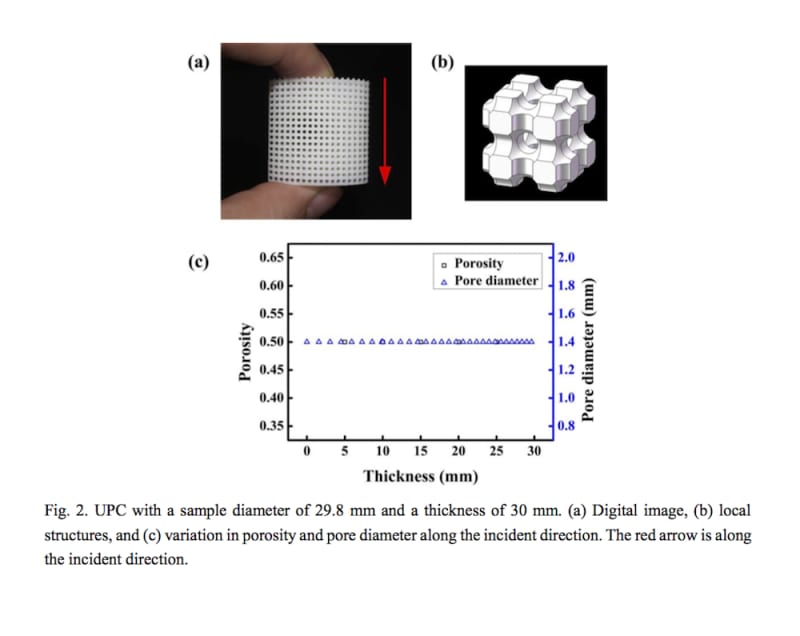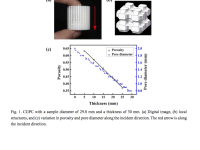Noise pollution could be either harmful or annoying to humans and animals. As reported by WHO in 2011, “environmental noise leads to a disease burden that is only second in magnitude to that from air pollution.” Materials for noise control are in demand.
Phononic crystals (PCs) consist of periodic structures, which are engineered to manipulate acoustic wave propagation. Since PCs were first proposed by Kushwaha et al., much attention has been devoted to PCs because of their substantial applications in sound attenuation, absorber, etc. Continuously graded phononic crystals (CGPCs) are special types of PCs with continuously graded structures, which are verified to have superior sound absorption performance by experiments.
In this entry, three-dimensional(3D) CGPCs are designed and fabricated with photosensitive resin by means of 3D printing [Fig. 1(a)]. The sound absorption performance of CGPCs is compared with that of uniform phononic crystals (UPCs).
Fig. 1(b) shows the local structures of the CGPCs. Fig. 1(c) shows the variation in porosity and pore diameter along the incident direction of a CGPC. UPCs are designed for reference. They are porous cylinders with uniform, periodic structures and produced using 3D printing [Fig. 2].
The sound absorption characteristics of CGPC-0.6-20 mm are augmented significantly, compared with that of UPC-0.6-20 mm [Fig. 3(a)]. In particular, the two peaks for CGPC-0.6-20 mm are 0.98 (at 2300 Hz) and 0.97 (at 5300 Hz). The turning point frequency, below which the absorption coefficient is less than 0.2, decreases to 1380 Hz for CGPC-0.6-20 mm. The frequency ranges, above which the sound absorption coefficients are above 0.56, are broadened (1800–3000 Hz plus 4400–6300 Hz).
For the sample CGPC-0.6-30 mm, the values of the two sound absorption peaks are 0.99 and 0.97 [Fig. 3(b)]. The high sound absorption coefficients (higher than 0.56) are obtained when the frequency is higher than 1350 Hz and the sound absorption coefficients are all higher than 0.2 in the studied frequency range.
Generally, CGPC-0.6-20 mm and CGPC-0.6-30 mm both have two peaks, whereas UPC-0.6-20 mm, and UPC-0.6-30 mm have one peak within the measured frequency range (1000–6300 Hz). These results suggest that CGPCs display more sound absorption coefficient peaks at a specific frequency range than UPCs, and hence more significant broadband sound absorption performance.
In summary, novel 3D CGPCs are designed and fabricated with photosensitive resin by means of 3D printing. Our experimental results show that, compared with UPCs, CGPCs demonstrate more efficient sound absorption performance at a large frequency range, a better sound absorption performance at a low-frequency range, and possibly a greater number of sound absorption peaks at a specific frequency range. In particular, the sound absorption coefficients of CGPC-0.6-30 mm are higher than 0.56 at 1350-6300 Hz, and are all higher than 0.2 in the studied frequency range (1000–6300 Hz). The CGPCs could be potentially applied in noise control.
Study on the novel CGPCs has been published in the article: AIP Advances 6, 105205 (2016).
Like this entry?
-
About the Entrant
- Name:Xiuhai Zhang
- Type of entry:teamTeam members:Xiuhai Zhang and Di Tian Xi’an Jiaotong University, Xi’an, P.R. China
- Software used for this entry:COMSOL and SolidWorks
- Patent status:pending








